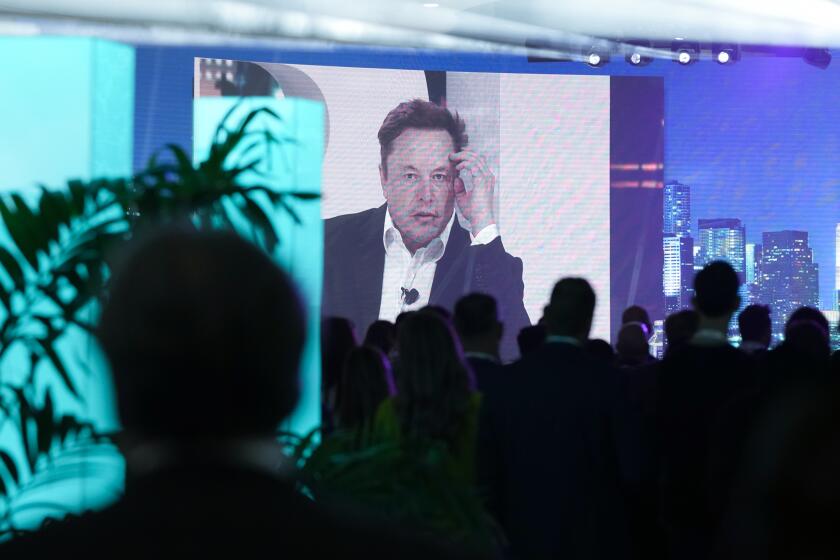Column: The richest Americans finished paying their Social Security taxes last week. Most of us will pay all year

- Share via
Here are some rough calculations of when some of America’s richest individuals fulfilled their Social Security tax obligations for 2025: For Apple Chief Executive Tim Cook, it was at about 2 p.m. on New Year’s Day. For McDonald’s CEO Christopher Kempczinski, sometime on the morning of Jan. 3. For Elon Musk, it was sometime around 12:31 a.m. New Year’s Day.
For most of the rest of us, it won’t happen until next New Year’s Eve.
The real figures on the payroll tax liabilities of America’s plutocrat class are necessarily murky, for reasons we’ll get to in a moment. But they tell a dismal story nonetheless, as set forth annually by labor economist Teresa Ghilarducci of the New School.
A lot of income escapes the Social Security system; and the escaping income is that from the wealthiest Americans.
— Economist Teresa Ghilarducci
The story is one of rising economic inequality in United States — and more specifically how our tax system is designed to benefit the wealthy rather than ordinary workers. Anyone needing empirical evidence of these conditions need not look beyond the way we fund Social Security, our indispensable federal retirement and disability program.
Although the program is designed to provide universal coverage, the burden of paying for it falls disproportionately on the working class. Under the program’s current structure, benefits are progressive — they come to a larger percentage of lifetime earnings for lower-income retirees — but the tax is regressive, amounting to less as a percentage of income as income rises.
Get the latest from Michael Hiltzik
Commentary on economics and more from a Pulitzer Prize winner.
You may occasionally receive promotional content from the Los Angeles Times.
At least 230 of the richest Americans already have paid their Social Security tax for the year, Ghilarducci reports. That’s because wage earnings of $176,100 or more this year — the cap on wages taxed by Social Security — are exempt, and their income is so high that they reached the ceiling within days or even minutes of the New Year’s ball dropping at Times Square.
“A civil engineer earning $176,100 per year looks the same as Elon Musk in the eyes of the Social Security system,” Ghilarducci writes. By contrast, “over 164 million workers (about 94% of us) pay Social Security taxes all year long. The point is a lot of income escapes the Social Security system; and the escaping income is that from the wealthiest Americans.”
One of the most effective Social Security reforms proposed by Democrats is to raise or (preferably) eliminate the payroll tax cap. But that change doesn’t go quite far enough. What’s necessary, as Ghilarducci correctly observes, is to bring more income categories — interest, business receipts, capital gains — into the definition of earnings.
“Taxing the expanded base could more than pay for promised Social Security benefits for 35 years and there would even be some money to eliminate poverty among all Social Security recipients,” she observes.
Rep. Mike Lee and Elon Musk put their heads together to craft an attack on Social Security utterly devoid of truth.
Here’s a brief primer on the payroll tax, which typically appears on pay stubs under the label “FICA” (for “Federal Insurance Contributions Act”). For Social Security, it comes to 12.4% of gross wage income, shared equally by worker and employer, up to an annually adjusted cap. In 2025, the cap is $176,100, up from $168,600 last year. That means that you’ll pay a maximum of $10,918 directly in Social Security tax this year, with your employer paying the same sum on your behalf. (Self-employed workers have to pay both levies.)
Workers and employers each pay an additional 1.45%, with no cap, to help fund Medicare. The richest taxpayers may also be subject to a 3.8% tax on some of their investment income.
Two aspects of the payroll tax are boons for the wealthy. One is that it applies only to wages, tips, bonuses, commissions, and some fringe benefits — generally, almost anything that appears on the annual W-2 forms workers receive from their employers. “Unearned income” such as interest, dividends and capital gains distributions isn’t counted.
That’s important because unearned income tends to represent a greater share of total income for the wealthy compared with the rank and file.
In tax year 2022 (the most recent for which the IRS provides statistics), W-2 income accounted on average for about 75% of the total income reported by households with adjusted gross income of $50,000-$75,000. For households with income of $1 million or more, only about 25% was subject to the payroll tax. For those with income of $10 million or more (averaging about $30.4 million each), only about 12% on average was subject to the payroll tax — and then only up to the FICA cap.
To put it another way, any workers earning wages of $176,100 or less this year will pay 6.2% of their pay in Social Security tax. For someone earning $10 million, assuming all of it comes in wages, the tax rate is 0.11%.
Trump tried to cut Social Security in the past, so why should you believe he won’t try again? Watch for these ‘gimmicks.’
That brings us to the complexities involved in gauging the income of America’s richest individuals, notably top corporate executives. Mostly to reduce corporate and income taxes, companies tend to keep the cash components of their executives’ pay as meager as possible, as opposed to stock and stock options. The latter aren’t subject to the payroll tax.
Apple, for example, listed Cook’s total compensation for 2023 (the most recent year reported) as $63.2 million. But only $3 million of that was in salary, plus another $10.7 million reported as a cash incentive tied to the company’s performance. An additional $2.5 million was paid for items such as security services and personal travel on private aircraft, which Apple requires Cook to use “for security and efficiency reasons.” Cook may have to pay tax on some of those items.
It’s difficult, and in some cases impossible, to figure out how much in cash a top corporate executive actually pockets in any year. The Securities and Exchange Commission implemented a regulation in 2022 mandating that public companies disclose “compensation actually paid” to top executives, ostensibly so shareholders could accurately assess how the money paid to the C-suite corresponded to a company’s performance.
In practice, however, the resulting metrics obscure almost as much as they reveal. Apple, for example, disclosed in its 2024 proxy statement that in 2023 it “actually paid” $106.6 million to Cook — but it also stated that the figure “does not represent cash or equity value realized or paid” to Cook, or to the company’s four other top executives.
Rather, the “actually paid” disclosure is merely a way to adjust the value of stock options and other equity awards given to the executives, as the value of the underlying shares rises or falls. So if you’re trying to determine how much more the bank accounts of executives swelled during the year, this is no help.
Elon Musk says he’s relocating his companies to Texas because California laws ‘attack ... families.’ Wait till he learns about Texas laws restricting parents’ rights over their own children.
Musk’s income from Tesla, his publicly traded electric vehicle company, is especially hard to gauge. (Ghilarducci says she based her estimate of Musk’s potential tax liability on “public data on Musk’s income,” including nonwage income.)
According to Tesla’s disclosure, Musk received no salary, bonus, stock or options from 2021 through 2023. That may have something to do with the issues connected with his groundbreaking $56-billion 2018 pay package, which was challenged in a shareholder lawsuit. The pay package was overturned in January 2024 by Delaware Chancellor Kathaleen McCormick, who found it excessive and not the product of an arm’s length negotiation between Musk and the Tesla board. (Tesla didn’t respond to my request for comment.)
That points to how the wealthy exploit their assets without incurring income tax, whether on ordinary or “unearned” income: They borrow against them. Tesla has disclosed that as of last March, Musk had pledged more than 238.4 million of his Tesla shares — about one-third of the total 715 million shares of which he was listed as beneficial owner — as “collateral to secure certain personal indebtedness.” The pledged stock is worth about $95 billion at the current stock price. The proceeds of loans aren’t generally treated as taxable income unless the loan is forgiven.
Tesla disclosed in its proxy statement in April that the compensation it “actually paid” Musk came to $1.4 billion in 2023. But it stated — as Apple did in relation to Cook’s pay — that the figure did “not reflect the actual amount of compensation earned by or paid to Mr. Musk” that year. It was merely an artifact of adjustments to the putative value of his stock grants as it fluctuated in relation to the value of the underlying shares.
So whether Musk paid his entire payroll tax obligation by 15 minutes into 2025 (as Ghilarducci estimated based on Musk’s total Tesla-connected wealth), or owed nothing and has paid nothing can’t be determined.
All we can say is this: The run-up of wealth among a tiny camp of mega-billionaires comes at great social cost. Conservatives and Republicans in Congress continue to claim that the cost of Social Security, Medicare and Medicaid benefits is an insupportable burden on America, so benefits need to be cut, though President-elect Donald Trump has vowed to preserve entitlements like Social Security and Medicare.
But if the wealthy paid their fair share of the cost of those programs, they might well be solvent, even flush enough for benefits to be expanded and extended, into the limitless future.
More to Read
Get the latest from Michael Hiltzik
Commentary on economics and more from a Pulitzer Prize winner.
You may occasionally receive promotional content from the Los Angeles Times.














